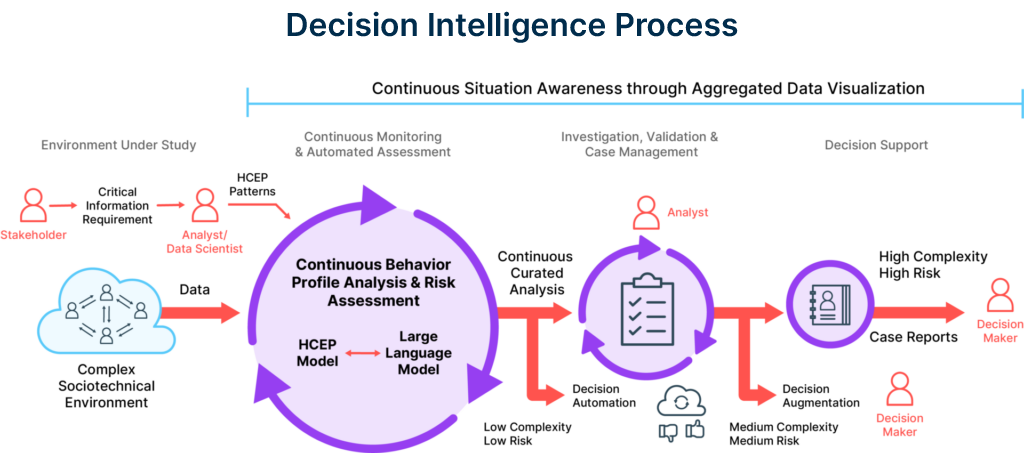
To view the first part of this blog, click here.
Continuous Decision Intelligence Explained
The goal of continuous decision intelligence is to attain a proactive versus reactive posture to an organization’s challenges. This is achieved by applying predictive analytics, using Cogility’s expert AI analytic technology and a decision intelligence process enabling decision makers to make highly informed and timely decisions.

Good intelligence can be classified in terms of relevancy, actionability, confidence (e.g. risk) and timeliness. A seamless Decision Intelligence (DI) process includes the collection, analysis and decision-making approaches that best suit the organization’s mission. As illustrated in the above graphic, Cogynt has embraced these concepts in building a comprehensive Decision Intelligence Platform (DIP) to streamline DI the application delivery processes.
The Cogynt Decision Intelligence Platform facilitates key DI processes by providing event streaming (data in motion) capability enabled by highly scalable Apache Kafka and Flink, which are market leading and proven stream processing technologies. These tools are augmented with Cogility’s patented expert AI analytic technology based on Hierarchical Complex Event Processing (HCEP). HCEP is the analytic core that allows internet scale processing power, is further enhanced with Cogynt’s easy to use no-code authoring environment enabling agility (to quickly define and deploy analytic changes) which is essential in reducing the typical DI application code-test-code-test cycles. As a result, the HCEP analytic produces highly curated, traceable insights to support flexible analysis and decision processes – from decision automation to case management to decision support.

The above graphic shows Cogynt’s Authoring, Analyst Workstation and Superset Business Intelligence (BI) user interfaces. The curated insights are made available through an intuitive UI, called Analyst Workstation, where the analysts have the flexibility to seamlessly evaluate and investigate any of the curated events to support a given intelligence investigation. Advanced situational awareness is made available with the Analyst Workstation for specific events whereas SuperSet is used for aggregated BI analysis. If findings or other subjects as part of decision support requires further examination or teaming, Cogynt has integrated case management capability that allows any workflow process to be defined. This facilitates collaboration to ensure the findings can be enriched and fully vetted.
In many cases this ensures specialists’ notifications, contributions, and approvals are captured and considered at the proper times.
Cogynt continuous Decision Intelligence Real-Time Analytic – HCEP
Cogynt is distinguished from all other DIP and event streaming platforms because of HCEP. A form of expert-based AI, HCEP is based on five basic principles:
- Computational Hierarchy — which is in the form of a Directed Acyclic Graph (DAG). This allows for increasing levels of abstraction which is essential in transforming data into insight.
- Stateful CEP — is stateful in that the HCEP DAG maintains its history of matched or partially matched patterns. This is critical for auditability, validity assessments and responding in real time to complex situations with historical components.
- Continuous Risk Assessment — for fully or partially matched patterns, statistical events are generated based on Bayesian or other preferred risk model approaches. This continuously reevaluates risk for all new data upon arrival.
- Manual Actions — this allows for an analyst to refute pattern matches, based on a potential false positive or other reason, and Cogynt will automatically recompute the risk score and all other implications of the change.
- Event Pattern Constraint Language (EPCL) — is a no code domain specific language that allows analysts and data scientists to easily create and deploy behavioral models applying HCEP principles.
HCEP empowers the analyst to discover difficult to detect signatures or profiles that many rule-based, ML and Gen AI solutions will miss. HCEP is expert driven, with the power of hierarchical stateful event pattern matching. ML and Gen AI solutions can be limited due to the lack of training data and it is ill-equipped to identify new signatures that are not represented in training data, generally are black boxes that lack explainability.
Cogility’s HCEP overcomes these challenges. HCEP is expert driven so, an HCEP model does not require training and the model is stateful, so analyst can view the causal relationships between events and more effectively validate the analytic result. These advantages have been demonstrated with AI Bot swarm detections that social media companies have not been able to detect. For more information, please see the YouTube video recently posted https://www.youtube.com/watch?v=afuY8hXVop8
Challenges and Considerations
Event stream processing, and real-time analytic technologies are available for free from Apache Foundation such as Apache Kafka, Flink and Pinot. However, unless your organization has tremendous technical depth and financial resources to build and maintain a DIP architecture, it will be a very difficult and costly undertaking. Cogility offers Cogynt as a complete DIP for DI application development offering accelerated time to value. It can be deployed within a few hours. Organizations can start building DI applications almost immediately with nominal authoring training.
Conclusion
Decision Intelligence Platform is a new class of platform technology to support DI application development enabled through event stream processing, real-time analytics, decision automation, augmentation and support, and business process integration. DI offers the ability to reduce operational risk and enhance decision support making in the most complex environments where timely and informed decision making is essential to competitiveness.
